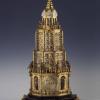Clock with Automated Procession of Bacchus
Commentary
Clock with Automated Procession of Bacchus
Hans Schlottheim, Augsburg, c. 1580
Bronze, Copper, Gilding, Enamel, Painting
H: 71cm, W: 39cm, D: 30.5cm
Maximilianmuseum, Kunstsammlungen und Museen Augsburg, Inventory Number 5739
This fine clock, believed to have been owned by the Electors of Saxony, was created by one of Augsburg’s most coveted clockmakers and one renowned for inventing witty automated assemblages. The clock’s timekeeping functions include the display of hours and minutes as well as astronomical calendar functions, which could be used to predict the dates of celestial events and holidays.
To mark each hour the clock mechanism chimes a bell contained in the miniature bell tower and activates the movement of figures at the base. A typical feature of Schlottheim’s clocks, the indication of time is secondary to the regular activation of ingenious automata which embody the piece’s general theme. These moving figures are luxuriously dressed in the attributes of Ottoman Turks, who were intended to represent all followers of Islam. They represent an orientalised ‘other,’ or rather a group of people who are human but behave differently, almost as a mechanical human is somehow both familiar and an exotic spectacle. Turks became a common motif of the automata of the early modern period, as their ‘otherness’ took on a variety of political values, such as the Ottoman threat to the Holy Roman Empire in which this clock was made. The exoticism of the orient is here fused with that of Greco-Roman mythology and the group of Turks accompany the figure of Bacchus on a sedan chair. But this Bacchus is not all he seems, and as he mechanically lifts a sausage to his mouth upon the ringing of an hour, we realise that he is also the folk character Hanswurst. Like Bacchus, Hanswurst is a character whose foolish appearance belies a peculiar yet potent intelligence. His Turkish followers, then, are presented as more cunning than they may appear, and their possession of a compass, globe, and armillary sphere suggests a considerable level of knowledge that may be at odds with any perceived Eastern decadence. As a sophisticated conversation piece, the clock, which is surmounted by a crescent and supported by four sphinxes, celebrates an ancient and seemingly otherworldly wisdom rooted in mathematics and astronomy.
Commentary: Andrew Biedermann (April, 2022)
Sources:
https://kunstsammlungen-museen.augsburg.de/maximilianmuseum-lieblingsstuecke
Aytes, Ayhan, “The “Other” in the Machine: Oriental Automata and the Mechanization of the Mind.” PhD Thesis, University of California, San Diego, 2012.

